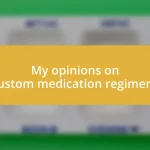Key takeaways:
- Prenatal genetic testing offers insights into potential genetic disorders, allowing parents to make informed decisions about their child’s future.
- Emotional responses to test results can vary greatly; the process often strengthens family bonds and sparks important conversations about fears and hopes.
- Support from others who share similar experiences can be crucial in navigating the psychological impact of genetic testing results.
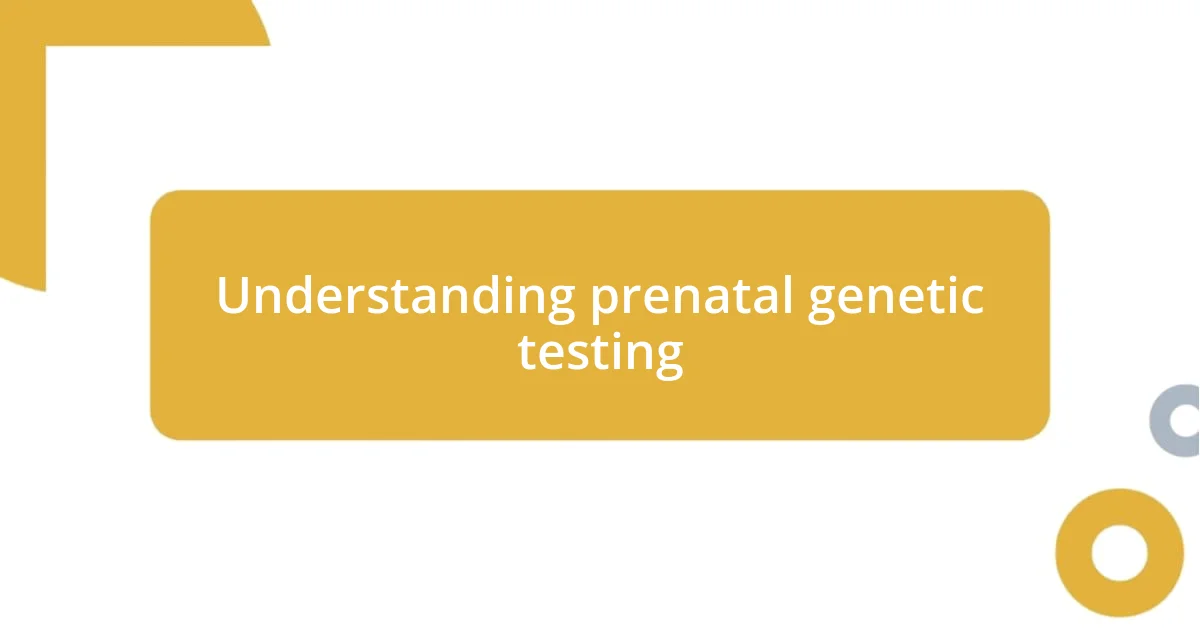
Understanding prenatal genetic testing
Prenatal genetic testing involves analyzing a fetus’s genetic makeup to identify potential genetic disorders or abnormalities. I remember sitting in the doctor’s office, heart racing, when I first learned about the different testing options available. It’s a mix of hope and anxiety, wondering what you might uncover about your child’s future.
One of the main types of prenatal genetic testing is non-invasive prenatal testing (NIPT), which uses a blood sample from the mother to assess the risk of certain conditions, like Down syndrome. It’s fascinating how such advanced technology can provide insights even before birth, but it also left me pondering—how much do you really want to know? The peace of mind that comes from knowing your baby’s health is comforting, but it can also be pretty overwhelming.
Another method is chorionic villus sampling (CVS), which involves taking a sample of the placenta. This invasive procedure can provide definitive results but also carries risks, which made me feel torn during my decision-making process. It’s an emotional rollercoaster, reflecting on what it means to have this information—will my choices change based on what I learn? I found that grappling with these questions is a vital part of the prenatal journey.
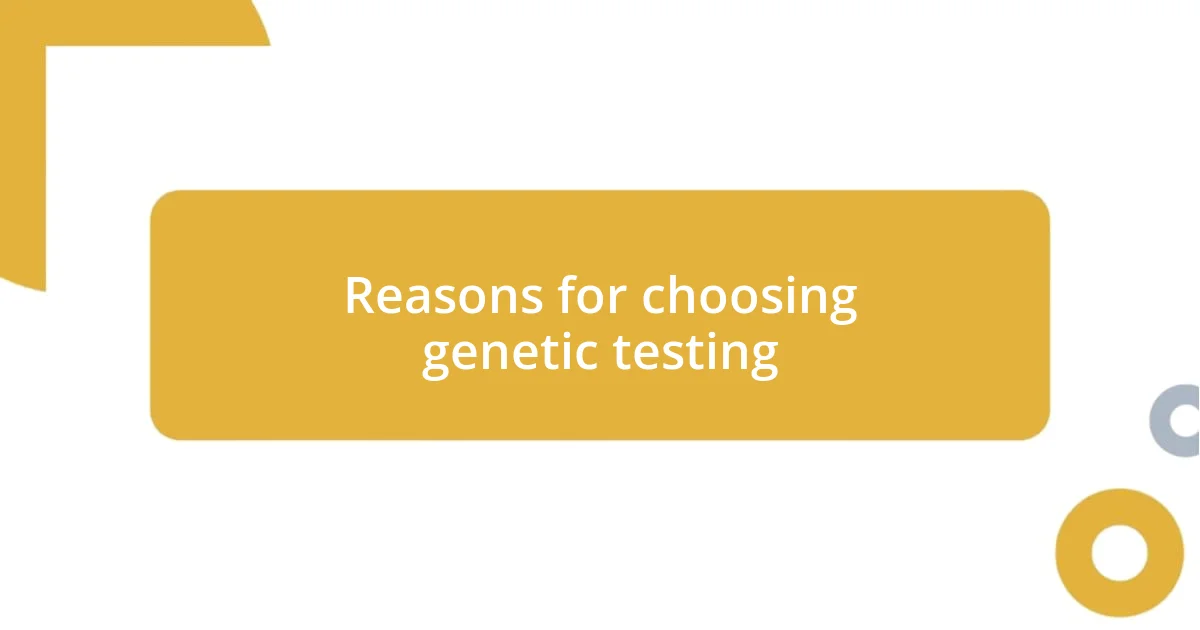
Reasons for choosing genetic testing
Choosing genetic testing during pregnancy can be a deeply personal decision influenced by various factors. For me, the desire to prepare and understand any potential challenges played a significant role. It’s natural to want to ensure the best possible outcome for your child, and genetic testing can provide critical insights that shape one’s approach to pregnancy and parenthood.
Here are some common reasons for opting for prenatal genetic testing:
- Early Detection: Identifying genetic disorders as soon as possible allows families to prepare emotionally and logistically for any challenges ahead.
- Informed Decision-Making: When I received my test results, it empowered me to make informed choices about my care and my baby’s needs.
- Family Planning: Understanding potential genetic conditions can help expectant parents consider future family planning and resources.
- Peace of Mind: Knowing the risks helps to alleviate anxiety; that sense of clarity truly resonated with me during those crucial moments.
- Personal or Family History: If there’s a known genetic disorder in the family, testing becomes an essential way to assess risk for the unborn child.
Deciding to pursue genetic testing is often tied to the hope of being equipped for whatever lies ahead. In my experience, each bit of information felt like a building block towards a stronger foundation for my family’s future.

Types of prenatal genetic tests
When it comes to the different types of prenatal genetic tests, it’s all about understanding the options available. Non-invasive prenatal testing (NIPT), for example, quickly became a favorite of mine due to its simplicity and safety. I found comfort in knowing that a simple blood draw could offer valuable insights about potential chromosomal abnormalities without putting my baby at risk.
On the other hand, there’s chorionic villus sampling (CVS), an option that requires more invasive measures but can provide definitive results. I remember the tension in the air during my consultation; the doctor explained that while the risks associated with CVS were higher, the information it could yield was crucial for making serious decisions. It made me wonder—what truly matters more: the risk or the knowledge?
The amniocentesis test is another procedure that might come up in discussions about prenatal testing. It involves collecting amniotic fluid, which contains fetal cells, to analyze for genetic conditions. Thinking back, I likened it to peering into a crystal ball—nervous yet eager for what it might reveal. Each type of testing offers valuable insights, but the emotional weight of that knowledge is something each parent must grapple with on their own journey.
| Type of Test | Description |
|---|---|
| Non-Invasive Prenatal Testing (NIPT) | Uses a mother’s blood sample to assess risks of chromosomal abnormalities. |
| Chorionic Villus Sampling (CVS) | Involves taking a sample of the placenta; provides definitive results but carries risks. |
| Amniocentesis | Collects amniotic fluid for analysis; offers insights into genetic conditions with some risks involved. |
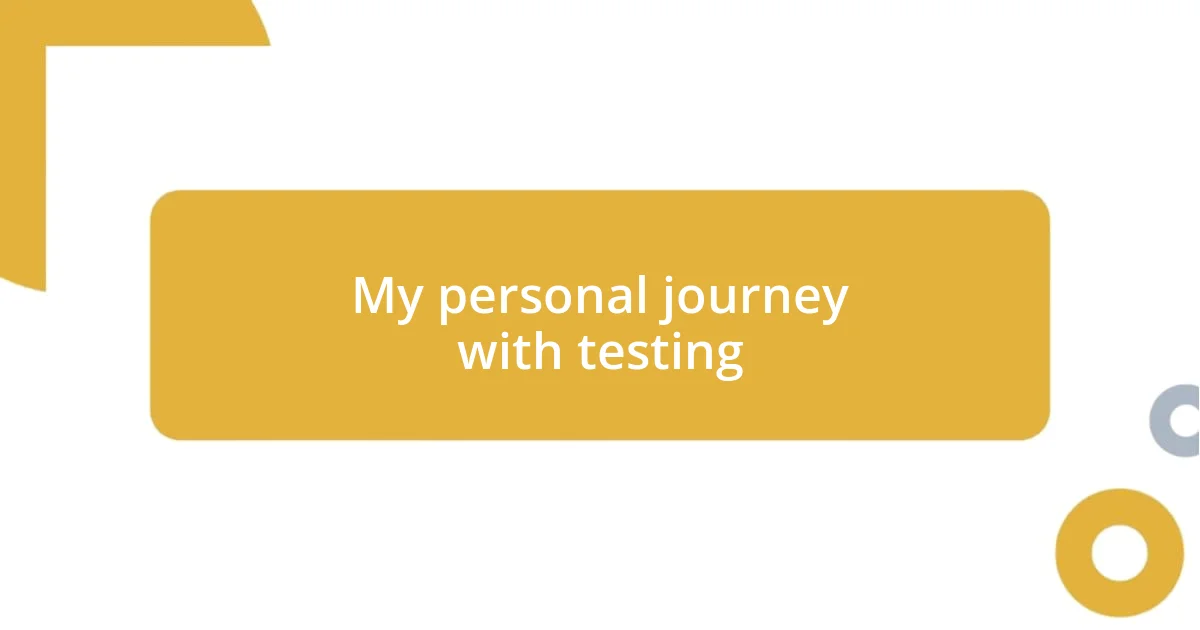
My personal journey with testing
My personal journey with prenatal genetic testing began with a whirlwind of emotions. As I sat in the doctor’s office, I felt a mix of anticipation and anxiety about what the tests might reveal. I remember asking myself, “What if I discover something I’m not prepared for?” This uncertainty didn’t fade, but my drive to understand and prepare for my child’s future pushed me forward.
The day I received my test results still stands out vividly in my mind. My heart raced as I opened the email, a surge of hope mingled with fear. I can’t help but think how being informed allowed me to take proactive steps in my pregnancy. It felt like I finally had my hands on the steering wheel of my own journey rather than drifting along wherever fate would take me.
I’ve often reflected on what it meant to me personally to go through this testing process. It wasn’t just about the results; it was about the conversations it sparked with my partner and family. We navigated the complexities of our choices together, and that connectivity created a bond that I deeply cherish. In the end, I realized that understanding the unknown brought us closer as a family, transforming fear into strength.

Interpreting test results and outcomes
Interpreting test results can feel like deciphering a secret code, especially when the implications weigh so heavily on a parent’s heart. I recall the moment I received my NIPT results; I experienced a strange cocktail of relief and apprehension. It was a surreal experience—understanding the risk percentages was one thing, but grappling with the potential outcomes for my baby was an emotional rollercoaster.
When it came time to discuss the results with my doctor, I felt like I was embarking on a deep dive into my child’s health. Hearing phrases like “high risk” or “low risk” made me realize that these were more than just words on a paper; they represented choices that would shape our family’s future. Have you ever had a moment where a single word changed everything? For me, that word was “normal.” It was so simple, yet it felt like a weight lifted off my shoulders. Those conversations helped me understand that these results were not an endpoint, but rather a guide for what lay ahead.
Navigating the emotional landscape of genetic testing results can be challenging. I often found myself contemplating, “Why did I choose to undergo this testing?” For me, the answer was clear: knowledge gave me strength. Even when faced with uncertainty, having a framework to discuss potential outcomes with my loved ones made everything feel a bit more manageable. This journey wasn’t about fearing the results; it was about empowering ourselves with information, regardless of what we might face.

Psychological impact of genetic testing
The psychological impact of genetic testing is often a complex mosaic of emotions. I remember walking through the day-to-day after learning about my baby’s risk factors; it was like carrying a weight I couldn’t see but always felt. Would I overthink every kick or movement that didn’t feel right? It’s that inner dialogue that can sometimes spiral into anxiety, as worries about the future loom larger than life.
Then there’s the conversations that become inevitable. After sharing my results with friends, I was surprised by the range of reactions. Some friends expressed relief, reassuring me that I’d made the right choice, while others shared their own apprehensions about testing. It opened my eyes to how personal this journey truly is. Have you ever felt alone in your experiences, only to discover through sharing that it’s a universal struggle? Those discussions brought unexpected comfort, reminding me that I wasn’t navigating this emotional labyrinth alone.
As the weeks turned into months, I began to see how prenatal genetic testing impacted not just me, but my entire family. I recall a heartfelt moment with my parents who expressed both concern and support, revealing the depth of their love. It became apparent that these tests weren’t merely clinical—they ignited deeper discussions about family, legacy, and dreams for the future. Have you thought about how much our decisions echo beyond ourselves? Every choice we make during this journey resonates within the walls of our homes and hearts, ultimately shaping bonds that can weather any storm.
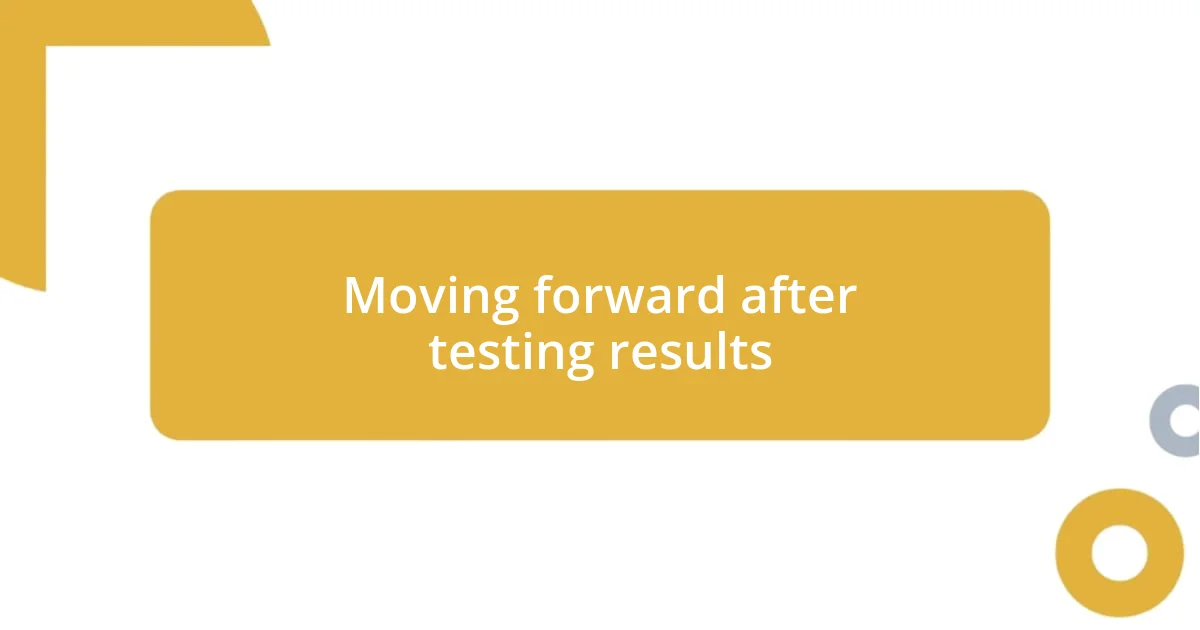
Moving forward after testing results
After receiving the testing results, the path forward often feels unclear. I remember sitting at my kitchen table, staring blankly at a cup of coffee while processing what the results meant for us. It raised questions—would we need to prepare for a different journey than we imagined? Navigating those thoughts can be tough, but I found comfort in creating an action plan, considering my options step by step.
With each conversation about the results, it became evident that connection with my partner was vital. Early on, we sat down and openly shared our fears and hopes. It wasn’t always easy—some discussions felt like walking on eggshells—but those honest moments became the foundation for our decision-making process. The act of sharing helped us both feel less isolated; have you ever noticed how discussing fears often lightens their weight?
Moving forward, I also discovered the importance of seeking support from others who had walked a similar path. I joined a support group online, where experiences were shared, and stories exchanged. Hearing others articulate their emotional journeys created a sense of community I desperately needed. Sometimes, the best way to heal is simply to know you’re not alone, right? In those discussions, I came to realize that while the results were significant, how we responded as a family could truly shape our experience.


